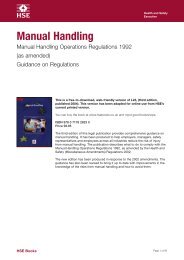Making Companies Safe - what works? (CCA ... - Unite the Union
Making Companies Safe - what works? (CCA ... - Unite the Union
Making Companies Safe - what works? (CCA ... - Unite the Union
Create successful ePaper yourself
Turn your PDF publications into a flip-book with our unique Google optimized e-Paper software.
Chapter Seven<br />
Campaigning, and educational<br />
Activities<br />
Campaigns<br />
Two HSE-commissioned reviews of <strong>the</strong> numerous UK evaluations of awareness-raising<br />
campaigns came to slightly conflicting conclusions about <strong>the</strong>ir value. Wright et al. state<br />
that <strong>the</strong>se evaluations have indicated that ‘such work is effective in raising awareness,<br />
and awareness is an important factor in improving health and safety precautions’ 1 . However,<br />
Hillage et al. concluded that while <strong>the</strong>re is evidence that HSE can ‘reach’ a significant<br />
proportion of employers, <strong>the</strong>re is:<br />
“very little evidence that being ‘reached’ by <strong>the</strong> campaign actually translates into<br />
action, let alone positive and demonstrable benefits in occupational health.” 2<br />
Thus, even though campaigns may be associated with higher levels of awareness and<br />
knowledge as argued by Wright et al, <strong>the</strong> evidence that this <strong>the</strong>n impacts on organisational<br />
attitudes and behaviour is not strong. This is for two reasons. First, some evaluations simply<br />
showed little evidence of campaigns having led to action, although this is partly because<br />
of <strong>the</strong> methodological problems involved in showing this. 3 Second, even where <strong>the</strong>re is an<br />
association between awareness of a campaign and propensity to take action on<br />
occupational health and safety (OHS) this does not mean that <strong>the</strong> one caused <strong>the</strong> o<strong>the</strong>r. As<br />
Hillage et al. argue in relation to Wright et al.’s evaluation of <strong>the</strong> ‘Good Health is Good<br />
Business’ campaign:<br />
“Aware organisations were more predisposed towards having an interest in health<br />
and safety issues in general, so <strong>the</strong> changes need not necessarily be attributed to<br />
<strong>the</strong> campaign.” 4<br />
A fur<strong>the</strong>r example of <strong>the</strong> weak link between awareness of a campaign and subsequent<br />
action can also be found in an evaluation of <strong>the</strong> HSC’s voluntary guidance on directors<br />
responsibilities for health and safety which we have discussed earlier (see chapter two).<br />
Magnitude and Quality of <strong>the</strong> Changes<br />
Even if changes or differences in attitude and behaviour between aware and unaware<br />
organisations could be attributed with any certainty to <strong>the</strong> impacts of a particular campaign,<br />
<strong>the</strong>re are still questions as to <strong>the</strong> size and quality of <strong>the</strong> changes observed.<br />
A consideration of <strong>the</strong> evaluation of <strong>the</strong> ‘Good Health is Good Business’ (GHGB) campaign<br />
illustrates <strong>the</strong>se points. 5 The evaluation reports that, in relation to <strong>the</strong> impact of <strong>the</strong> campaign<br />
on employer attitudes, <strong>the</strong>re were statistically significant differences between organisations<br />
that were aware of <strong>the</strong> GHGB campaign and unaware organisations as regards some (but not<br />
all) attitudes towards occupational health.<br />
However, in absolute terms <strong>the</strong> size of <strong>the</strong>se differences is extremely small. For instance, <strong>the</strong><br />
researchers found a statistically significant difference in <strong>the</strong> extent of change in concern<br />
for employees’ health between those organisation that were “aware” and those that<br />
were “unaware”. On a scale of 1 to 5 (where 5 is “concern has greatly increased”) “aware”<br />
organisations score 3.9 and “unaware” organisations score 3.6. The researchers also<br />
reported a statistically significant difference in <strong>the</strong> perceived balance of costs and benefits of<br />
59
















